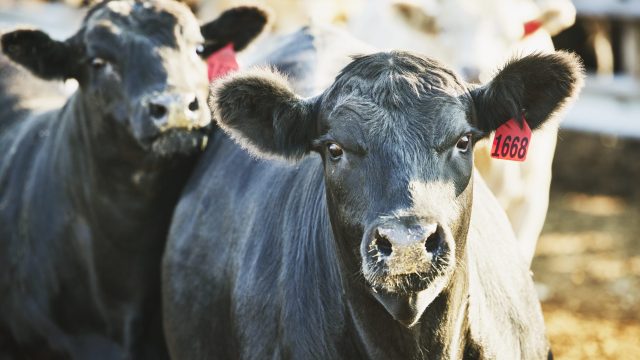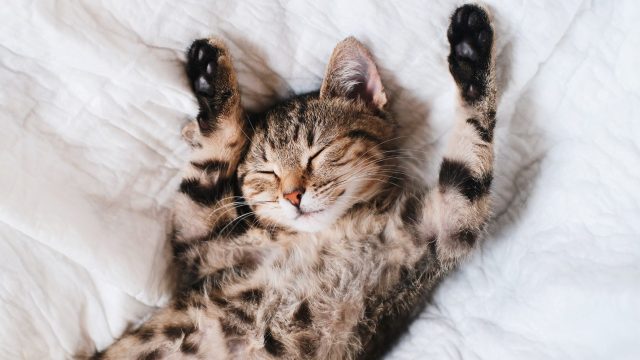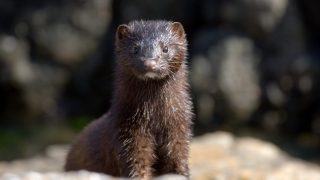
France to End Mink Farming, Use of Wild Animals in Traveling Circuses, and Captivity of Orcas and Dolphins in Marine Parks
By Nicole Pallotta, PhD, Senior Policy Program Manager
Contents
Summary/intro
Our country is now engaged in a major change in the place given to wild animals in our society. . . . This evolution of perceptions is the mark of a society conscious of its responsibility vis-à-vis a fragile nature. It is this movement that we are supporting by announcing the gradual end of the presence of wildlife in circuses, the presence of orcas and dolphins in dolphinariums and the end of mink farming in France.
– French Ecology Minister Barbara Pompili
As part of a broad package of animal protection measures, France has banned the farming of mink for their fur, captivity of dolphins and orcas in marine parks, and the use of wild animals in traveling circuses. Also included are new standards to improve the well-being of some species of animals held in zoos.
The announcement, which came in September 2020 from France’s Ecology Ministry, noted “our country is now engaged in a major change in the place given to wild animals in our society.” The decision to ban these forms of exploitation followed several months of joint discussions between the French government and various stakeholders, including NGOs, business representatives, elected officials, and experts “to understand issues related to respecting the physiological needs of animals and the well-being of captive wild animals.”
While the bans on mink farming and orca and dolphin captivity have concrete deadlines, the use of wild animals in traveling circuses does not, and instead will be phased out gradually over the coming years. Ecology Minister Barbara Pompili said, “setting a date doesn’t solve all the problems; I prefer to set up a process to make it happen as quickly as possible . . . solutions will be found on a case-by-case basis, with each circus, for each animal.”
Timelines
According to the government’s announcement, mink farming must be ended completely by 2025 and, effective immediately, no new mink farms may open. There are currently four mink farms operating in France. The ban comes after multiple undercover investigations by French animal rights organization One Voice, which drew public attention to the inherent cruelty of the fur industry, including intensive confinement and inhumane killing methods.
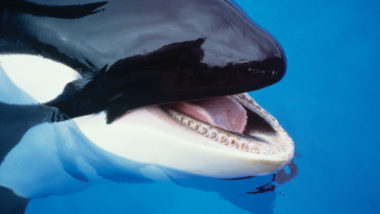 The timeline for marine parks is multi-tiered, with captivity of orcas to be phased out by 2022 and dolphins by 2027. Sanctuaries are named as an exception to the captivity ban, provided they are “sans spectacle” — without show or performance. Effective immediately, no new establishments using cetaceans for entertainment purposes will be approved and France’s three existing marine parks are prohibited from breeding or bringing new orcas or dolphins into their facilities.
The timeline for marine parks is multi-tiered, with captivity of orcas to be phased out by 2022 and dolphins by 2027. Sanctuaries are named as an exception to the captivity ban, provided they are “sans spectacle” — without show or performance. Effective immediately, no new establishments using cetaceans for entertainment purposes will be approved and France’s three existing marine parks are prohibited from breeding or bringing new orcas or dolphins into their facilities.
The circus ban does not have a deadline for existing establishments but no new traveling circuses that use wild animals will be issued permits, effective immediately. “The measures would affect about 80 circuses, which have some 230 animals, including big cats, elephants, hippos, wolves and others,” Minister Pompili said. Local legislation to ban the use of wild animals in circuses had reportedly already been adopted in 400 communities in France, and approximately 20 European countries have enacted similar bans.
While lacking a distinct deadline, the circus ban directly acknowledges the needs of wild animals. The fact that these needs cannot be met in conditions of “roaming detention” forms the rationale for the ban, which calls out specific animal species as being particularly unsuitable for such conditions:
Prohibition of the keeping of animals of wild species of which the degree of incompatibility of the roaming detention with their needs is important (in particular the wild animals, the monkeys, the bears, the wolves or those requiring ponds or large quantities of (water like hippos, sea lions, elephants, etc.).
Importantly, the French government has set aside funding to support and retrain workers who will need to find new employment as a result of the measures.
Finally, the measures mandate creation of new standards and oversight for wild animals held in zoos directed at their species-appropriate needs, including:
- Establishment of detention standards aimed at improving the well-being of captive wildlife in zoos for certain species, such as the polar bear (temperature, access to shadow areas, etc.);
- Introduction of supervision measures for shows in zoos (example: prohibition of the public to touch animals).
Support for Workers and Animals
Policies like these challenge companies to create new business models and, in some cases, workers to find new jobs. It also creates the need for animals freed from captivity who cannot be released into the wild to be placed in a permanent home that can meet their needs as best as possible.
Noting “it is a transformation of entire sectors that we are undertaking,” the French government announced its intention to collaborate with the affected industries “to support these transitions under the best conditions for companies, staff and animals.” This support includes the allocation of specific funds to assist workers affected by these new policies.
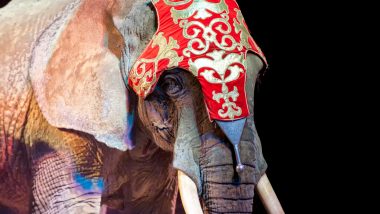 According to France Blue, Minister Pompili said, “We ask them (in circuses) to reinvent themselves. It will be a period when they will need support. The state will be at their side.” To this end, the government created a budget of 8 million euros (approximately US $9.4 million) to support the retraining of workers in the sectors affected by the legislation and help them transition to new jobs.
According to France Blue, Minister Pompili said, “We ask them (in circuses) to reinvent themselves. It will be a period when they will need support. The state will be at their side.” To this end, the government created a budget of 8 million euros (approximately US $9.4 million) to support the retraining of workers in the sectors affected by the legislation and help them transition to new jobs.
The government also announced it will support the development of sanctuaries to provide homes for animals who will be freed from circuses and marine parks, as well as contributing thoughts on the placement of these animals.
Criticisms
While acknowledging the measures — which come after years of campaigning by animal activists — are a step in the right direction, some have criticized them for being too vague and falling short of steps taken by other countries. Advocates have been particularly critical of the lengthy timelines for implementation of these bans — and in the case of circuses, the lack of a deadline altogether. French animal rights organization One Voice, which has conducted multiple undercover investigations of France’s fur farms and was part of the working group that consulted with the government on these measures, wrote:
What exactly are we talking about? A law? Ordinances? Orders? As too often in France on this subject, we have waited a long time for vague and minimal progress. . . . These measures go in the right direction, but are too weak, are far from sweeping enough subjects and fall far short of societal expectations! . . . the Minister does not set a framework, a date, or the means to achieve this. Obviously, these words have the benefit of existing, but the government should not think that we will be content to compromise. We can’t wait another ten, fifteen years for the next advances! Animals will not be able to.
One Voice criticized the five-year transition period for mink farms, particularly given there are only four remaining in France (with several having closed in just the last few years). They and other advocates are requesting the government close France’s remaining fur farms in advance of the 2025 deadline.
Noting that Poland — the world’s third largest fur supplier — is currently working to close its fur farms and the Netherlands — which banned fur in 2013 with a 20-year transition period — had moved up its timeline to shutter the country’s approximately 130 fur farms by spring 2021,1 One Voice said “we see that France is taking its time.”
 Activists also want the ban — which applies only to minks — extended to the farming of rabbits for their fur. Orylag rabbits, a genetically manipulated and trademarked breed developed by the French National Research Institute for Agriculture, are farmed only in France and their fur is used primarily by luxury fashion brands. Like mink farms, undercover investigations on Orylag rabbit farms have revealed cruel conditions and resulted in criminal complaints brought by L214, 2 the activist group that conducted the investigations.
Activists also want the ban — which applies only to minks — extended to the farming of rabbits for their fur. Orylag rabbits, a genetically manipulated and trademarked breed developed by the French National Research Institute for Agriculture, are farmed only in France and their fur is used primarily by luxury fashion brands. Like mink farms, undercover investigations on Orylag rabbit farms have revealed cruel conditions and resulted in criminal complaints brought by L214, 2 the activist group that conducted the investigations.
Regarding the criticisms, the Law Library of Congress notes that:
Indeed. . . the government did not specify what legal vehicles, such as regulations or legislation, will support the planned measures. However, it should be noted that the measures announced by Minister Pompili are largely consistent with a broader bill that was submitted to Parliament on August 25, 2020. This bill goes much further than Minister Pompili’s announcement: in addition to banning performances by nondomestic animals within five years, it would ban the farming of not only mink but of all animals for their fur. The bill would also ban certain types of hunting. . . and would gradually ban the keeping of poultry, swine, and other farm animals in cages.
French Referendum for Animals
In July 2020, a broad coalition of French animal protection organizations launched a citizen’s referendum for animals, which would enable the public to vote directly on measures to prohibit the following: intensive farming (including the use of cages and keeping animals indoors with no outside access); fur farming; recreational hunting; performances with wild animals; and animal testing.
The referendum, which reportedly has widespread public support and has been endorsed by prominent business leaders, must receive support from 185 (out of 925) members of parliament and 10% of registered voters in order to be placed on the ballot. Organizers have one year to gather the required signatures.
Recent opinion polls have revealed support among the French public for reforms related to animal protection across a wide array of issues. More than two thirds of participants in a survey conducted earlier this year indicated they want better animal protection measures. In the poll, which asked about several issues covered by the proposed referendum, 73% of respondents said they favored measures to help companies organize performances without wild animals; 77% said they support a ban on breeding animals for furs; 91% said they support an obligation to give animals outdoor access; and 73% support a ban on animal testing within ten years.
Similar Measures in the U.S. and Worldwide
Circuses
More than 45 countries worldwide have restricted or banned the use of wild animals in circuses, according to the summary of a federal bill — The Traveling Exotic Animal and Public Safety Protection Act — that would amend the Animal Welfare Act to restrict the use of wild animals in traveling performances in the U.S.
In recent years, legislation prohibiting the use of animals in circuses has gained momentum in the U.S. In just the last two years, three states — New Jersey (2018), Hawaii (2018), and California (2019) — have banned the use of wild animals in circuses. In addition, New York and Illinois have banned the use of elephants in traveling acts, and Rhode Island bans the use of bullhooks, which effectively ends the use of elephants in entertainment as these cruel implements are needed to force elephants to “perform.” At the local level, more than 150 cities and counties across the U.S. have enacted bans on the use of wild animals in circuses and traveling acts. For more information, including ways to pass similar legislation in your state or community, see our resource: Prohibiting Circuses and Traveling Acts that Use Animals.
Cetaceans in Captivity
 Consistent with the shift in public attitudes about circuses, the use of cetaceans like orcas and dolphins in entertainment has come under increasing societal scrutiny in recent years. Countries besides France that have either banned the captivity of dolphins or orcas,3 or enacted such strict regulations as to comprise a de facto ban, include Bolivia, Brazil, Chile, Costa Rica, Greece, Hungary, India, Luxembourg, Norway, Switzerland, the U.K., and — most recently in 2019 — Canada. There is no federal law in the U.S. that prohibits the keeping of cetaceans in captivity but some states have enacted bans, including South Carolina (cetaceans) and California (orcas only). In many cases, even where prohibitions exist, captive orcas and dolphins continue to languish, as bans typically apply only to the breeding or acquisition of new animals without requiring that animals who were already in captivity be relocated to sanctuaries.
Consistent with the shift in public attitudes about circuses, the use of cetaceans like orcas and dolphins in entertainment has come under increasing societal scrutiny in recent years. Countries besides France that have either banned the captivity of dolphins or orcas,3 or enacted such strict regulations as to comprise a de facto ban, include Bolivia, Brazil, Chile, Costa Rica, Greece, Hungary, India, Luxembourg, Norway, Switzerland, the U.K., and — most recently in 2019 — Canada. There is no federal law in the U.S. that prohibits the keeping of cetaceans in captivity but some states have enacted bans, including South Carolina (cetaceans) and California (orcas only). In many cases, even where prohibitions exist, captive orcas and dolphins continue to languish, as bans typically apply only to the breeding or acquisition of new animals without requiring that animals who were already in captivity be relocated to sanctuaries.
Fur Production and Sales
Several countries have enacted legislation to ban fur farming, with the U.K. being the first to do so in 2000. 4 Others have restricted it enough to comprise a de facto ban. 5 For example, Germany enacted such strict animal welfare regulations that fur farming became economically infeasible. 6 The issue is currently being debated by the governments of several countries as well.
In the U.S., California has been a leader on this issue. In 2018, San Francisco became the first major city in the world — and the third city in California—to ban the sale of fur. 7 In 2019, California enacted an historic statewide ban on the production and sale of new fur, effective in 2023 — the first U.S. state to do so.
The global fur industry has also been affected by the COVID-19 pandemic. Outbreaks of the virus — a version of which can infect both minks and humans — on mink farms around the world have caused some countries to accelerate existing plans to phase out their fur industries. The Netherlands, for example, banned fur farming in 2013 with a 2024 effective date, but moved that timeline up to March 2021 following outbreaks of the new strain of COVID-19 on mink farms across the country. In November 2020, Denmark — the world’s largest producer of fur — announced that all captive minks would be killed (approximately 17 million animals) following outbreaks of the virus in a quarter of the nation’s fur farms. The mass killings have almost wiped out the fur industry in Denmark, with some speculating it may not recover. According to BBC, the chair of the Danish Mink Breeders Association said: “It is a de facto permanent closure and liquidation of the fur industry.”
Conclusion
France’s new measures are part of a shift in societal attitudes regarding holding wild animals captive across a wide array of sectors. Increasingly, courts and lawmakers are recognizing that the species-specific needs of wild animals — such as the opportunity to engage in natural behaviors — are frequently ignored in captivity, and that this must change. The reference to the needs of wild animals in France’s announcement is compatible with the strong language on display throughout a recent important decision issued by the Islamabad High Court, which found that wild animals have legal rights. The Animal Legal Defense Fund continues to work on multiple fronts to advance animals’ legal status, and to ensure our legal system protects all animals’ right to thrive and live their lives according to their emotional and physical capacities.
Further Reading
- Murray, Adrienne. “Fur industry faces uncertain future due to Covid.” BBC. November 24, 2020.
- Boring, Nicholas. “France: French Government Announces Ban on Wild Animal Performances and Mink Farming.” Global Legal Monitor. October 7, 2020.
- French Ministry of Ecological Transition. “Barbara Pompili announces new measures in favor of captive wildlife.” Press Release. September 29, 2020.
References
- This expedited timeline was due to COVID-19, which infected mink and then workers on a Dutch fur farm in April 2020. By summer, the virus had spread to a third of the country’s fur farms. In June 2020, the government voted to shut the industry down as soon as possible.
- L214, also known as L214 Éthique et Animaux. is named after the section of France’s rural code that recognizes animals as “sentient beings,” which was added in 1976.
- Some bans apply to either orcas or dolphins, while others cover both. Some bans also include porpoises. A report by World Animal Protection that surveyed publicly accessible facilities worldwide that keep cetaceans in captivity found that eight out of ten are dolphins.
- The U.K. government is currently considering a ban on the sale of fur — in addition to its existing production ban — following Brexit. Thus far, India is the only nation that has banned the import or sale of fur.
- For example, mandating considerably larger cages or swimming basins for mink. For details, see: https://www.furfreealliance.com/wp-content/uploads/2020/05/National-legislation-fur-farming-Europe.pdf
- Some fur bans apply only to certain species, for example foxes. See the Fur Free Alliance, which lobbied for France’s ban, for details about fur bans worldwide: https://www.furfreealliance.com/fur-bans/
- San Francisco’s fur ban was upheld in 2020 following a constitutional challenge: https://aldf.org/article/san-francisco-fur-ban-upheld-as-challenge-is-dismissed/
Related
-
Tyson Foods Agrees to Stop Making ‘Net-zero’ and ‘Climate-smart Beef’ Claims
Lawsuit alleged Tyson Foods falsely claimed it will be net-zero by 2050 and marketed its industrial beef products as “climate-smart”November 17, 2025 Press Release -
City of Sturgeon Agrees to Pay $500,000 in Settlement Over Police Shooting of Blind, Deaf Dog
The lawsuit argued the lethal force used violated the 4th amendmentNovember 14, 2025 Press Release -
California Governor Signs Animal Protection Bills into Law
The Animal Legal Defense Fund sponsored two bills protecting cats and wild animalsOctober 21, 2025 News

